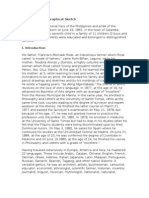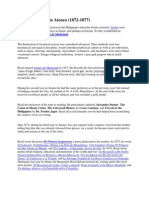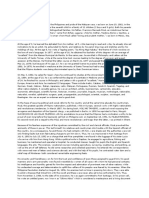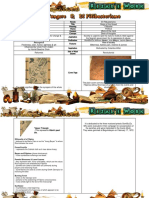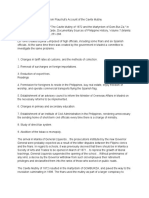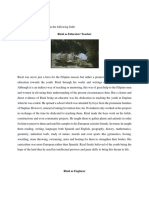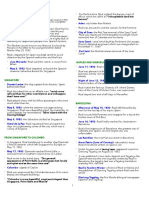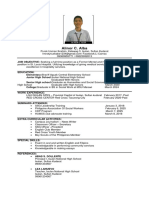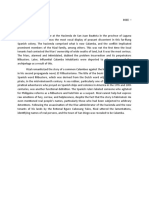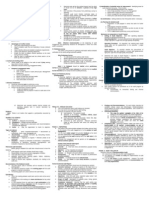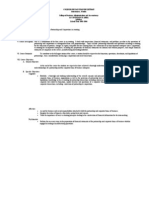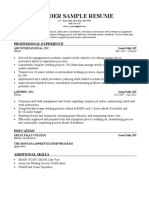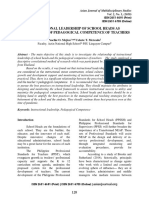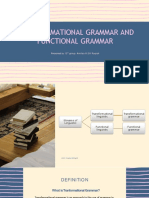Dr. Jose Rizal
Dr. Jose Rizal
Uploaded by
rajahmati_28Copyright:
Available Formats
Dr. Jose Rizal
Dr. Jose Rizal
Uploaded by
rajahmati_28Original Description:
Copyright
Available Formats
Share this document
Did you find this document useful?
Is this content inappropriate?
Copyright:
Available Formats
Dr. Jose Rizal
Dr. Jose Rizal
Uploaded by
rajahmati_28Copyright:
Available Formats
JOS PROTASIO RIZAL MERCADO Y ALONSO REALONDA The Mercado - Rizal Family The Rizals is considered one of the
biggest families during their time. Domingo Lam-co, the family's paternal ascendant was a full-blooded Chinese who came to the Philippines from Amoy, China in the closing years of the 17th century and married a Chinese half-breed by the name of Ines de la Rosa. Researchers revealed that the Mercado-Rizal family had also traces of Japanese, Spanish, Malay and Even Negrito blood aside from Chinese. Jose Rizal came from a 13-member family consisting of his parents, Francisco Mercado II and Teodora Alonso Realonda, and nine sisters and one brother. FRANCISCO MERCADO (1818-1898) Father of Jose Rizal who was the youngest of 13 offsprings of Juan and Cirila Mercado. Born in Bian, Laguna on April 18, 1818; studied in San Jose College, Manila; and died in Manila. TEODORA ALONSO (1827-1913) Mother of Jose Rizal who was the second child of Lorenzo Alonso and Brijida de Quintos. She studied at the Colegio de Santa Rosa. She was a business-minded woman, courteous, religious, hard-working and well-read. She was born in Santa Cruz, Manila on November 14, 1827 and died in 1913 in Manila. SATURNINA RIZAL (1850-1913) Eldest child of the Rizal-Alonzo marriage. Married Manuel Timoteo Hidalgo of Tanauan, Batangas. PACIANO RIZAL (1851-1930) Only brother of Jose Rizal and the second child. Studied at San Jose College in Manila; became a farmer and later a general of the Philippine Revolution. NARCISA RIZAL (1852-1939) The third child. married Antonio Lopez at Morong, Rizal; a teacher and musician. OLYMPIA RIZAL (1855-1887) The fourth child. Married Silvestre Ubaldo; died in 1887 from childbirth. LUCIA RIZAL (1857-1919) The fifth child. Married Matriano Herbosa. MARIA RIZAL (1859-1945) The sixth child. Married Daniel Faustino Cruz of Bian, Laguna. JOSE RIZAL (1861-1896) The second son and the seventh child. He was executed by the Spaniards on December 30,1896. CONCEPCION RIZAL (1862-1865) The eight child. Died at the age of three. JOSEFA RIZAL (1865-1945) The ninth child. An epileptic, died a spinster. TRINIDAD RIZAL (1868-1951) The tenth child. Died a spinster and the last of the family to die. SOLEDAD RIZAL (1870-1929) The youngest child married Pantaleon Quintero.
Dr. Jos Protasio Rizal Mercado y Alonso Realonda (June 19, 1861 December 30, 1896, Bagumbayan), was a Filipino polymath, nationalist and the most prominent advocate for reforms in the Philippines during the Spanish colonial era. He is considered a national hero of the Philippines, and the anniversary of Rizal's death is commemorated as a Philippine holiday called Rizal Day. Rizal's 1896 military trial and execution made him a martyr of the Philippine Revolution. The seventh of eleven children born to a wealthy family in the town of Calamba, Laguna, Rizal attended the Ateneo Municipal de Manila, earning a Bachelor of Arts. He enrolled in Medicine and Philosophy and Letters at the University of Santo Tomas and then traveled alone to Madrid, Spain, where he continued his studies at the Universidad Central de Madrid, earning the degree of Licentiate in Medicine. He attended the University of Paris and earned a second doctorate at the University of Heidelberg. Rizal was a polyglot conversant in at least ten languages. He was a prolific poet, essayist, diarist, correspondent, and novelist whose most famous works were his two novels, Noli me Tangere and El filibusterismo.These are social commentaries on the Philippines that formed the nucleus of literature that inspired dissent among peaceful reformists and spurred the militancy of armed revolutionaries against the Spanish colonial authorities. As a political figure, Jose Rizal was the founder of La Liga Filipina, a civic organization that subsequently gave birth to the Katipunan[8] led by Andrs Bonifacio and Emilio Aguinaldo. He was a proponent of institutional reforms by peaceful means rather than by violent revolution. The general consensus among Rizal scholars, however, attributed his martyred death as the catalyst that precipitated the Philippine Revolution.
JOSE RIZAL, the national hero of the Philippines and pride of the Malayan race, was born on June 19, 1861, in the town of Calamba, Laguna. He was the seventh child in a family of 11 children (2 boys and 9 girls). Both his parents were educated and belonged to distinguished families. His father, Francisco Mercado Rizal, an industrious farmer whom Rizal called "a model of fathers," came from Bian, Laguna; while his mother, Teodora Alonzo y Quintos, a highly cultured and accomplished woman whom Rizal called "loving and prudent mother," was born in Meisic, Sta. Cruz, Manila. At the age of 3, he learned the alphabet from his mother; at 5, while learning to read and write, he already showed inclinations to be an artist. He astounded his family and relatives by his pencil drawings and sketches and by his moldings of clay. At the age 8, he wrote a Tagalog poem, "Sa Aking Mga Kabata," the theme of which revolves on the love of ones language. In 1877, at the age of 16, he obtained his Bachelor of Arts degree with an average of "excellent" from the Ateneo Municipal de Manila. In the same year, he enrolled in Philosophy and Letters at the University of Santo Tomas, while at the same time took courses leading to the degree of surveyor and expert assessor at the Ateneo. He finished the latter course on March 21, 1877 and passed the Surveyors examination on May 21, 1878; but because of his age, 17, he was not granted license to practice the profession until
December 30, 1881. In 1878, he enrolled in medicine at the University of Santo Tomas but had to stop in his studies when he felt that the Filipino students were being discriminated upon by their Dominican tutors. On May 3, 1882, he sailed for Spain where he continued his studies at the Universidad Central de Madrid. On June 21, 1884, at the age of 23, he was conferred the degree of Licentiate in Medicine and on June 19,1885, at the age of 24, he finished his course in Philosophy and Letters with a grade of "excellent." Having traveled extensively in Europe, America and Asia, he mastered 22 languages. These include Arabic, Catalan, Chinese, English, French, German, Greek, Hebrew, Italian, Japanese, Latin, Malayan, Portuguese, Russian, Sanskrit, Spanish, Tagalog, and other native dialects. A versatile genius, he was an architect, artists, businessman, cartoonist, educator, economist, ethnologist, scientific farmer, historian, inventor, journalist, linguist, musician, mythologist, nationalist, naturalist, novelist, opthalmic surgeon, poet, propagandist, psychologist, scientist, sculptor, sociologist, and theologian. He was an expert swordsman and a good shot. In the hope of securing political and social reforms for his country and at the same time educate his countrymen, Rizal, the greatest apostle of Filipino nationalism, published, while in Europe, several works with highly nationalistic and revolutionary tendencies. In March 1887, his daring book, NOLI ME TANGERE, a satirical novel exposing the arrogance and despotism of the Spanish clergy, was published in Berlin; in 1890 he reprinted in Paris, Morgas SUCCESSOS DE LAS ISLAS FILIPINAS with his annotations to prove that the Filipinos had a civilization worthy to be proud of even long before the Spaniards set foot on Philippine soil; on September 18, 1891, EL FILIBUSTERISMO, his second novel and a sequel to the NOLI and more revolutionary and tragic than the latter, was printed in Ghent. Because of his fearless exposures of the injustices committed by the civil and clerical officials, Rizal provoked the animosity of those in power. This led himself, his relatives and countrymen into trouble with the Spanish officials of the country. As a consequence, he and those who had contacts with him, were shadowed; the authorities were not only finding faults but even fabricating charges to pin him down. Thus, he was imprisoned in Fort Santiago from July 6, 1892 to July 15, 1892 on a charge that anti-friar pamphlets were found in the luggage of his sister Lucia who arrive with him from Hong Kong. While a political exile in Dapitan, he engaged in agriculture, fishing and business; he maintained and operated a hospital; he conducted classes- taught his pupils the English and Spanish languages, the arts. The sciences, vocational courses including agriculture, surveying, sculpturing, and painting, as well as the art of self defense; he did some researches and collected specimens; he entered into correspondence with renowned men of letters and sciences abroad; and with the help of his pupils, he constructed water dam and a relief map of Mindanao - both considered remarkable engineering feats. His sincerity and friendliness won for him the trust and confidence of even those assigned to guard him; his good manners and warm personality were found irresistible by women of all races with
whom he had personal contacts; his intelligence and humility gained for him the respect and admiration of prominent men of other nations; while his undaunted courage and determination to uplift the welfare of his people were feared by his enemies. When the Philippine Revolution started on August 26, 1896, his enemies lost no time in pressing him down. They were able to enlist witnesses that linked him with the revolt and these were never allowed to be confronted by him. Thus, from November 3, 1986, to the date of his execution, he was again committed to Fort Santiago. In his prison cell, he wrote an untitled poem, now known as "Ultimo Adios" which is considered a masterpiece and a living document expressing not only the heros great love of country but also that of all Filipinos. After a mock trial, he was convicted of rebellion, sedition and of forming illegal association. In the cold morning of December 30, 1896, Rizal, a man whose 35 years of life had been packed with varied activities which proved that the Filipino has capacity to equal if not excel even those who treat him as a slave, was shot at Bagumbayan Field.
You might also like
- Prueba Diagnóstico Inglés 1 MedioDocument3 pagesPrueba Diagnóstico Inglés 1 MedioCatina Comicheo LevicoyNo ratings yet
- Marcelo H. Del Pilar Personal InfoDocument2 pagesMarcelo H. Del Pilar Personal InfoKizzha GodinezNo ratings yet
- Accounting For Manufacturing BusinessDocument56 pagesAccounting For Manufacturing Businessrajahmati_2890% (20)
- Distribution Management NestleDocument19 pagesDistribution Management Nestlehellboy1275% (4)
- Lykken (1957)Document5 pagesLykken (1957)Tadhg Euan DalyNo ratings yet
- Jose Rizal: A Biographical SketchDocument18 pagesJose Rizal: A Biographical SketchAlton Melvar M DapanasNo ratings yet
- Jose Rizal's Educational BackgroundDocument5 pagesJose Rizal's Educational BackgroundJobeth Murcillos100% (1)
- Life and Studies in AteneoDocument3 pagesLife and Studies in AteneoMichaelaNo ratings yet
- Rizal in SpainDocument23 pagesRizal in SpainEric Cabalsa SaraginaNo ratings yet
- Life and Works of Rizal SummaryDocument79 pagesLife and Works of Rizal SummaryAreel Galvan100% (1)
- Activity in RizalDocument4 pagesActivity in RizalGrenda MalauagNo ratings yet
- What Is Cavite MutinyDocument2 pagesWhat Is Cavite MutinyGenerose CamuNo ratings yet
- Aspect of Society Rizal's Observations As Depicted in The Noli Me Tangere Your Observations in The Present ContextDocument2 pagesAspect of Society Rizal's Observations As Depicted in The Noli Me Tangere Your Observations in The Present ContextRanelene CutamoraNo ratings yet
- Life and Works of RizalDocument6 pagesLife and Works of RizalKate William DawiNo ratings yet
- The Making of R.A. 1425Document3 pagesThe Making of R.A. 1425Reje CuaresmaNo ratings yet
- School Life at Ateneo and The University of Santo TomasDocument12 pagesSchool Life at Ateneo and The University of Santo TomasCedrick MatibagNo ratings yet
- Scholastic Triumphs at Ateneo de Manila (1872-187) : Chapter 4 - The Life and Works of Jose RizalDocument21 pagesScholastic Triumphs at Ateneo de Manila (1872-187) : Chapter 4 - The Life and Works of Jose Rizalanaperturescience0% (1)
- Novels Title Meaning Theme Content Concept Aspiration Dedication Features Inspiration Side of Rizal ShownDocument4 pagesNovels Title Meaning Theme Content Concept Aspiration Dedication Features Inspiration Side of Rizal ShownPammy AlivenNo ratings yet
- Imagining A NationDocument6 pagesImagining A NationLeahlainne Ministerio100% (1)
- Life and Works of Rizal Chapter 3: Political DevelopmentDocument4 pagesLife and Works of Rizal Chapter 3: Political DevelopmentMarie Vivialyn SerranoNo ratings yet
- The Three Important Provisions: The Nineteenth Century Philippine Economy, Society, and The Chinese MestizosDocument22 pagesThe Three Important Provisions: The Nineteenth Century Philippine Economy, Society, and The Chinese MestizosErika Sta. AnaNo ratings yet
- Chapter 4-5Document13 pagesChapter 4-5Shaina Marie GaroNo ratings yet
- Introduction To The Module Objective: I. PreliminariesDocument26 pagesIntroduction To The Module Objective: I. Preliminarieseva marie roblesNo ratings yet
- Timeline of Jose RizalDocument8 pagesTimeline of Jose RizalDoneva Lyn MedinaNo ratings yet
- Rizal's Formal EducationDocument6 pagesRizal's Formal EducationRoland Ramirez100% (2)
- RIZAL (Scrapbook)Document3 pagesRIZAL (Scrapbook)Jay ParkNo ratings yet
- Chapter 6Document3 pagesChapter 6jeselyn3delalamon3riNo ratings yet
- RIZAL CHAPTER 8 and 9Document6 pagesRIZAL CHAPTER 8 and 9Ken Eugene CabanelaNo ratings yet
- Group 6 SymbolismDocument2 pagesGroup 6 SymbolismKaden MaluyaNo ratings yet
- José RizalDocument3 pagesJosé Rizalsantos earl100% (3)
- PI 21 Chapter 8 - Rizal's Charges and ExecutionDocument9 pagesPI 21 Chapter 8 - Rizal's Charges and Executiondel143masNo ratings yet
- Misfortunes in MadridDocument2 pagesMisfortunes in MadridbeverlyNo ratings yet
- I. Compare and Contrast Rizal's in Ateneo and UST.: - There Were - During - The SchoolsDocument3 pagesI. Compare and Contrast Rizal's in Ateneo and UST.: - There Were - During - The SchoolsKRISTINA DENISSE SAN JOSENo ratings yet
- Childhood of Jose RizalDocument1 pageChildhood of Jose RizalDaniella Javier David100% (1)
- Life and Death of Jose RizalDocument10 pagesLife and Death of Jose RizalGeline Joy D. SamillanoNo ratings yet
- Life and Works of Jose Rizal: Prelim MidtermDocument23 pagesLife and Works of Jose Rizal: Prelim MidtermKang ChulNo ratings yet
- Early Life of Jose Rizal: Novels and EssaysDocument5 pagesEarly Life of Jose Rizal: Novels and EssaysMarkLesterEstrellaMabagosNo ratings yet
- 4 Scholastic Triumphs at Ateneo de ManilaDocument10 pages4 Scholastic Triumphs at Ateneo de ManilaFebbie Novem LavariasNo ratings yet
- The Year 1872 There Are 2 Historical EventsDocument2 pagesThe Year 1872 There Are 2 Historical EventsMonina AmanoNo ratings yet
- 6 Rizal in UST and Spain-R.damasoDocument42 pages6 Rizal in UST and Spain-R.damasoLeah RoseNo ratings yet
- Chapter 8 RizalDocument15 pagesChapter 8 RizalKarl BognotNo ratings yet
- HistoryDocument2 pagesHistoryKarl CrusNo ratings yet
- Rizal in Universidad Central de MadridDocument9 pagesRizal in Universidad Central de MadridDee Jay0% (1)
- The Martial Law Period Excerpt From Proclamation 1081 Titled "Proclaiming A State of Martial Law in The Philippines" Issued On September 21, 1972Document6 pagesThe Martial Law Period Excerpt From Proclamation 1081 Titled "Proclaiming A State of Martial Law in The Philippines" Issued On September 21, 1972Shelei Blanco IINo ratings yet
- LIFE and WORKS of RIZALDocument5 pagesLIFE and WORKS of RIZALYOONGINo ratings yet
- Many Faces of RizalDocument4 pagesMany Faces of RizalJuvie Anne DalmacioNo ratings yet
- The Life and Works of RizalDocument19 pagesThe Life and Works of RizalKiermoralesNo ratings yet
- Rizal Lecture 2Document6 pagesRizal Lecture 2hazelakiko torresNo ratings yet
- LWR ReviewerDocument33 pagesLWR ReviewerMaxsus SmithNo ratings yet
- Second Travel of RizalDocument5 pagesSecond Travel of RizalWendee PadillaNo ratings yet
- Rizal in EuropeDocument10 pagesRizal in EuropeMichellene TadleNo ratings yet
- A Brief Synopsis LRDocument3 pagesA Brief Synopsis LRJEFFREY VILLANGCANo ratings yet
- Rizal's Concept On Nation BuildingDocument12 pagesRizal's Concept On Nation BuildingJerome Chua100% (1)
- Rizal's Education in MadridDocument6 pagesRizal's Education in MadridFolie ElysianNo ratings yet
- Chapter 19-El Fili Published in Ghent PDFDocument25 pagesChapter 19-El Fili Published in Ghent PDFVal Vincent M. LosariaNo ratings yet
- Republic Act 1425 The Jose Rizal Law by SirJanDocument11 pagesRepublic Act 1425 The Jose Rizal Law by SirJanRay John DulapNo ratings yet
- Journal Life and Work of RizalDocument4 pagesJournal Life and Work of RizalMaria Angelika BughaoNo ratings yet
- Module in Rizal Week 1-2Document16 pagesModule in Rizal Week 1-2KiermoralesNo ratings yet
- Letter-and-Resume SampleDocument2 pagesLetter-and-Resume SampleShawn CamsaNo ratings yet
- Chapter 7 The Philippine RevolutionDocument20 pagesChapter 7 The Philippine RevolutionApril CaringalNo ratings yet
- Jose Rizal's Biography SummaryDocument4 pagesJose Rizal's Biography SummarySarah Montecillo100% (3)
- Chapter 5 Rizal in EuropeDocument39 pagesChapter 5 Rizal in EuropeJayann cabinasNo ratings yet
- Agrarian Disputes ReflectionDocument1 pageAgrarian Disputes ReflectionShaun Dela CruzNo ratings yet
- Agents of Apocalypse: Epidemic Disease in the Colonial PhilippinesFrom EverandAgents of Apocalypse: Epidemic Disease in the Colonial PhilippinesRating: 5 out of 5 stars5/5 (2)
- Elements of The Adjustment LetterDocument11 pagesElements of The Adjustment Letterrajahmati_28100% (1)
- Audit in Computerized EnvironmentDocument2 pagesAudit in Computerized Environmentrajahmati_280% (1)
- Rizal's Noli and The Savior of Noli, Tour With HimDocument37 pagesRizal's Noli and The Savior of Noli, Tour With Himrajahmati_28100% (3)
- Percentage Taxes NotesDocument4 pagesPercentage Taxes Notesrajahmati_28No ratings yet
- Audit ProcessDocument2 pagesAudit Processrajahmati_28No ratings yet
- Elements of PoetryDocument3 pagesElements of Poetryrajahmati_28No ratings yet
- Cost Benefit AnalysisDocument1 pageCost Benefit Analysisrajahmati_28No ratings yet
- The Gullible HusbandDocument2 pagesThe Gullible Husbandrajahmati_2867% (3)
- Types of Business Education ProgramsDocument5 pagesTypes of Business Education Programsrajahmati_28No ratings yet
- Why DepEd Prohibits The Collection of Contributions During The Enrollment PeriodDocument3 pagesWhy DepEd Prohibits The Collection of Contributions During The Enrollment Periodrajahmati_28100% (2)
- Business Law and Taxation ReviewerDocument5 pagesBusiness Law and Taxation ReviewerJeLo ReaNdelar100% (2)
- ACCTG2 - Introduction To Partnership and Corporation AccountingDocument13 pagesACCTG2 - Introduction To Partnership and Corporation AccountingJaylord Cruz27% (11)
- OBLICON Super ReviewerDocument110 pagesOBLICON Super ReviewerStefan Salvator81% (16)
- Auditing Theory SyllabusDocument7 pagesAuditing Theory Syllabusrajahmati_28No ratings yet
- Personality AttributesDocument36 pagesPersonality Attributesrajahmati_28No ratings yet
- Personality AttributesDocument36 pagesPersonality Attributesrajahmati_28No ratings yet
- VigneshDocument24 pagesVigneshselvi abrahamNo ratings yet
- Lplpo PKM Despot 2024'Document458 pagesLplpo PKM Despot 2024'angraenialiviaNo ratings yet
- Pe and Health 4 - Week 1 To 4Document19 pagesPe and Health 4 - Week 1 To 4MikeeeeNo ratings yet
- E2Tech Energy Forum ScheduleDocument2 pagesE2Tech Energy Forum Schedulegerald7783No ratings yet
- ISI Indexed Journals 14Document18 pagesISI Indexed Journals 14Osama Mohsen100% (1)
- Official Rules of MonoplyDocument2 pagesOfficial Rules of MonoplyKishan HalaiNo ratings yet
- Welder Sample Resume: Professional ExperienceDocument1 pageWelder Sample Resume: Professional ExperiencePhilip KrebsNo ratings yet
- Hoja de Practica 1 - Semana 2Document4 pagesHoja de Practica 1 - Semana 2Jose Sanchez NuñezNo ratings yet
- TRCRG Otsr Smed 069 02 Saf Mabuhay AccommDocument10 pagesTRCRG Otsr Smed 069 02 Saf Mabuhay AccommLeah PadillaNo ratings yet
- Color SequenceDocument1 pageColor SequenceFaheem HaiderNo ratings yet
- Barecon 89Document9 pagesBarecon 89Virgil TitimeauaNo ratings yet
- SiskeeDocument25 pagesSiskeeAbhilasha ShahNo ratings yet
- Master Catalog Final PDFDocument89 pagesMaster Catalog Final PDFak100% (1)
- Terms of Reference Communication Specialist For The Public Sector Services and Efficiency Enhancement ProgrammeDocument5 pagesTerms of Reference Communication Specialist For The Public Sector Services and Efficiency Enhancement ProgrammeNatasa ZdravkovskaNo ratings yet
- 348-Article Text-1077-1-10-20220304 89000Document16 pages348-Article Text-1077-1-10-20220304 89000Millet SantosNo ratings yet
- Betwin 257: Gulfstream ParkDocument15 pagesBetwin 257: Gulfstream ParkJoneibeth PaachecoNo ratings yet
- Rb751U 2HnD UgDocument8 pagesRb751U 2HnD UghenryqueNo ratings yet
- Gartner Jul 2020 - RemoteWorkTrendsDocument34 pagesGartner Jul 2020 - RemoteWorkTrendsFernando Bulnes Urrutia-CastroNo ratings yet
- Cindy's ResumeDocument3 pagesCindy's ResumeCindy FureyNo ratings yet
- Grammatical and Functional GrammarDocument8 pagesGrammatical and Functional Grammarsiti ruqiahNo ratings yet
- Internship of Canara BankDocument42 pagesInternship of Canara BankSachin KanojiyaNo ratings yet
- Report CRMDocument35 pagesReport CRMNhư Ý Nguyễn HoàngNo ratings yet
- Phonetic Keyboard (View Only)Document1 pagePhonetic Keyboard (View Only)Muhammad Arfan JadoonNo ratings yet
- Khutbah 11 Dec 09 - The Deen Is ClearDocument8 pagesKhutbah 11 Dec 09 - The Deen Is ClearRadamés Hakim H'eqalNo ratings yet
- Electrical ToolsDocument19 pagesElectrical ToolsAARONNo ratings yet
- Sounder Checklist EN 2023-09Document5 pagesSounder Checklist EN 2023-09Будимир ЗебићNo ratings yet
- Field Study Activity ContinuationDocument12 pagesField Study Activity ContinuationHelzven Junvy VegoNo ratings yet





